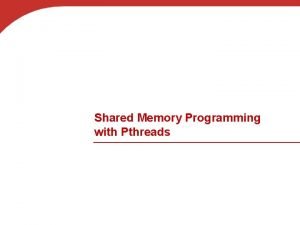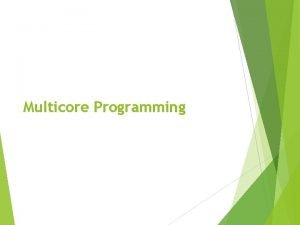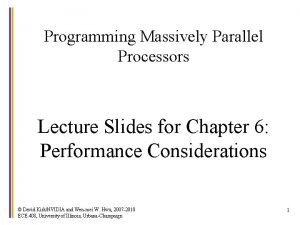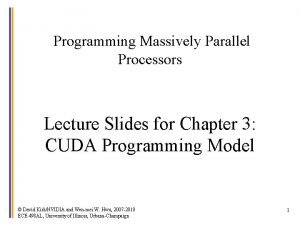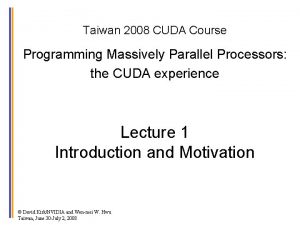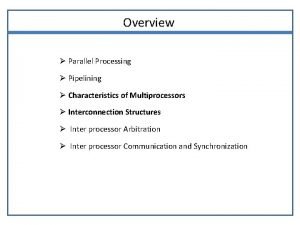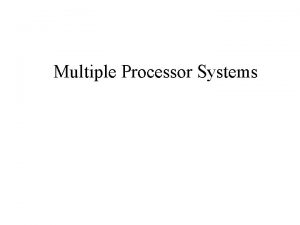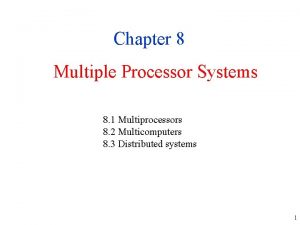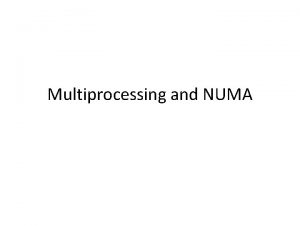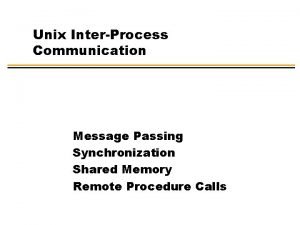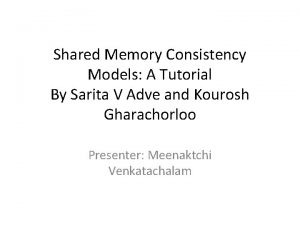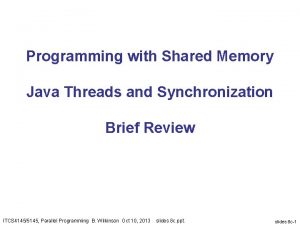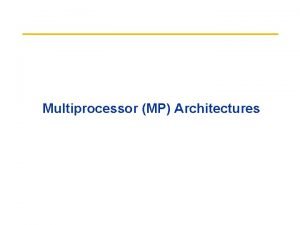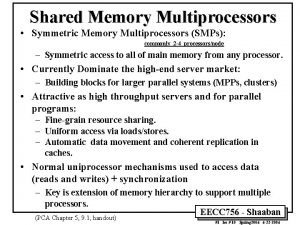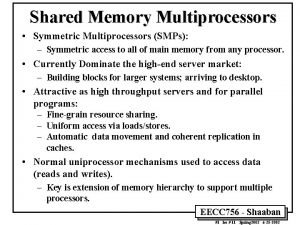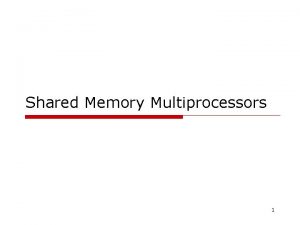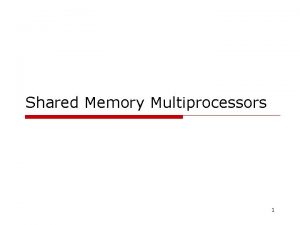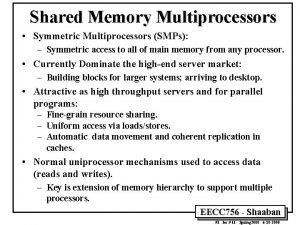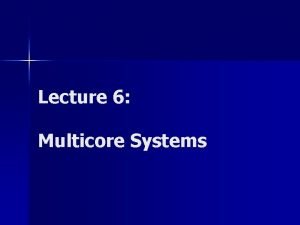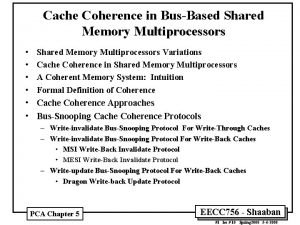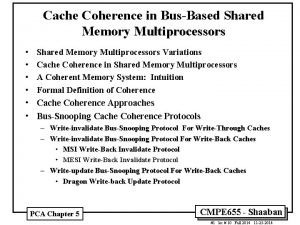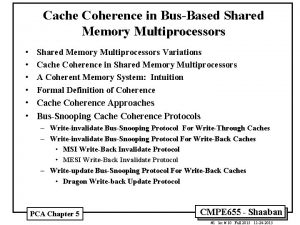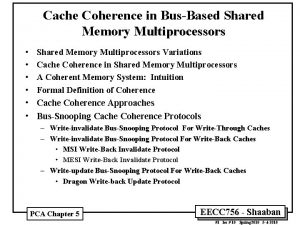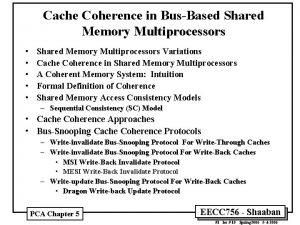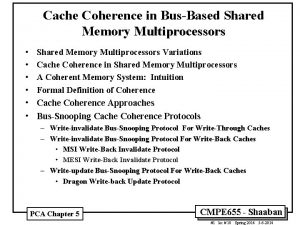Programming with Shared Memory Multiprocessors and Multicore Processors
















- Slides: 16

Programming with Shared Memory Multiprocessors and Multicore Processors ITCS 4145/5145, Parallel Programming B. Wilkinson Jan 13, 2016 1

Shared memory multiprocessor/multicore processor system Single address space exists – each memory location given unique address within single range of addresses. Any memory location can be accessible by any of the processors. Processors or processor cores Address 0 1 2 3 Memory locations Programming can take advantage of shared memory for holding data. However access to shared data by different processors needs to be carefully controlled, usually explicitly by programmer. 2

Concept of a process Basically a self-contained program having its own allocation of memory, stack, registers, instruction pointer, and other resources. Operating systems often based upon notion of a process. Processor time shared between processes, switching from one process to another. Might occur at regular intervals or when an active process becomes delayed. Offers opportunity to de-schedule processes blocked from proceeding for some reason, e. g. waiting for an I/O operation to complete. Process is the basic execution unit in message-passing MPI. 3

Fork pattern As used to dynamically create a process from a process Parent process Time Both main program and forked program sequence execute at the same time if resources available fork parent program sequence Child process “Forked” child program sequence Although general concept of a fork does not require it, child process created by the Linux fork is a replica of parent program with same instructions and variable declarations even prior to fork. However, child process only starts at fork and both parent and child process execute onwards together. 4

Multiple and nested fork patterns Main program fork Both main program and forked program sequence execute at the same time if resources available Parent program sequence fork “Forked” child program sequence fork “Forked” grandchild program sequence 5

Fork-join pattern Main program fork Both main program and forked program sequence execute at the same time if resources available “Forked” program sequence join Explicit “join” placed in calling parent program. Parent will not proceed past this point until child has terminated. Join acts a barrier synchronization point for both sequences. Child can terminate before join is reached, but if not, parent 8 a-6 will wait for it terminate.

UNIX System Calls to Create Fork-Join Pattern No join routine – use exit() to exit from process and wait() to wait for child to complete: . . pid = fork(); // returns 0 to child and positive # to parent (-1 if error) if (pid == 0) { // code to be executed by child } else { //code to be executed by parent } if (pid == 0) exit(0); else wait (0); // join. . 7

Using processes in shared memory programming Concept could be used for shared memory parallel programming but not much used because of overhead of process creation and not being able to share data directly between processes 8

Threads A separate program sequence that can be executed separately by a processor core, usually within a process. Threads share memory space and global variables but have their own instruction pointer and stack. An OS will manage threads within each process. Example my destop i 7 -3770 quad core processor. Supports 8 threads simultaneously (hyperthreading) 9

Threads in shared memory programming A common approach, either directly creating threads (a low level approach) or indirectly. 10

Really low level -- Pthreads IEEE Portable Operating System Interface, POSIX standard. proc 1(*arg) Fork-join “pattern” 11

// based upon wikipedia entry "POSIX Threads" http: //en. wikipedia. org/wiki/POSIX_Threads #include <pthread. h> #include <stdio. h> #define NUM_THREADS 5 void *slave(void *argument) { int tid = *((int *) argument); printf("Hello World! It's me, thread %d!n", tid); return NULL; } int main(int argc, char *argv[]) { pthread_t threads[NUM_THREADS]; int thread_args[NUM_THREADS]; int i; for (i = 0; i < NUM_THREADS; i++) { // create threads thread_args[i] = i; printf("In main: creating thread %dn", i); if ( pthread_create(&threads[i], NULL, slave, (void *) &thread_args[i] ) != 0) perror("Pthread_create fails"); } for (i = 0; i < NUM_THREADS; i++) { // join threads if ( pthread_join(threads[i], NULL) != 0 ) perror("Pthread_join fails"); printf("In main: thread %d is completen", i); } printf("In main: All threads completed successfullyn"); return 0; 12

Program on VM in directory Pthreads as hello. c Compile: cc –o hello. c -lpthread Sample Output Very simple to compile, Just add pthread library but Pthreads very low level programming In main: creating thread 0 In main: creating thread 1 In main: creating thread 2 In main: creating thread 3 In main: creating thread 4 Hello World! It's me, thread 4! Hello World! It's me, thread 0! Hello World! It's me, thread 1! Hello World! It's me, thread 2! In main: thread 0 is complete In main: thread 1 is complete In main: thread 2 is complete Hello World! It's me, thread 3! In main: thread 3 is complete In main: thread 4 is complete In main: All threads completed successfully 13

Pthreads detached threads Threads not joined are called detached threads. When detached threads terminate, they are destroyed and their resource released. Fork pattern 14

Common to need group of threads to be used together from one execution point. Thread pool pattern Pool of threads waiting to allocated Main program Group of threads readied to be allocated work and are brought into service. Whether threads actually exist or are created just for then is an implementation detail. Activated threads sequences Thread pool implies Generally a synchronization threads already point as fork-join pattern. created. Probably best as eliminates Thread pool pattern or the thread team pattern is the thread creation overhead. underlying structure of Open. MP, see next. 15

Questions 8 a-16
 Shared memory vs distributed memory
Shared memory vs distributed memory Google translate english to french
Google translate english to french Speedy transactions in multicore in-memory databases
Speedy transactions in multicore in-memory databases Multicore programming
Multicore programming Programming massively parallel processors
Programming massively parallel processors Programming massively parallel processors
Programming massively parallel processors Massively parallel processing ppt
Massively parallel processing ppt Programming massively parallel processors, kirk et al.
Programming massively parallel processors, kirk et al. Inter processor arbitration
Inter processor arbitration Interconnection structure of multiprocessor
Interconnection structure of multiprocessor Uma multiprocessors using multistage switching networks
Uma multiprocessors using multistage switching networks Multiple processor systems
Multiple processor systems Multiprocessor and multicore
Multiprocessor and multicore Shared memory in unix
Shared memory in unix Shared memory consistency models a tutorial
Shared memory consistency models a tutorial Shared memory java
Shared memory java Share a single centralized memory
Share a single centralized memory

